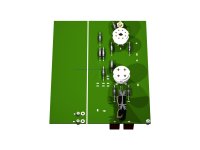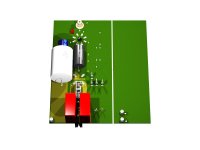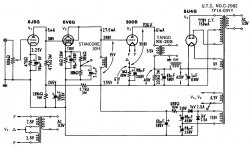Starting today.
To understand: new DHT supply (thread in this forum) .
.
HV supply from french LED magazine.
No electrolyt capacitors (customer can choose the type).
Try to find the best choice: Mundorf, WIMA MKS4, EPCOS MKP).
CMC tube socket, AMTRANS resistor, MILLS resistor.
Power components on top side .
.
Reduced cabling.
Any suggestion?
Attachments: first 3D View...
To understand: new DHT supply (thread in this forum)
 .
.HV supply from french LED magazine.
No electrolyt capacitors (customer can choose the type).
Try to find the best choice: Mundorf, WIMA MKS4, EPCOS MKP).
CMC tube socket, AMTRANS resistor, MILLS resistor.
Power components on top side
 .
.Reduced cabling.
Any suggestion?
Attachments: first 3D View...
Attachments
SE 300B mono amp
I have build a SE 300B monoamp by myself using Sowter "potted" output transformers and Sowter powertransformers with very good experience. For my brother I have build a SE 300B monoamp using ae-europe output and powertransformers, also with good experience. Mundorf caps are well.
I have build a SE 300B monoamp by myself using Sowter "potted" output transformers and Sowter powertransformers with very good experience. For my brother I have build a SE 300B monoamp using ae-europe output and powertransformers, also with good experience. Mundorf caps are well.
The coupling capacitor between 6SN7 and 300B is silver/oil grade. The other ones are today WIMA MKS4 and EPCOS MKP DC Link. No electrolyt capacitor for the moment.
I am try to understand the design of Rob Coleman DHT Gyrator/Current Sink for physical implementation on this board.
I am try to understand the design of Rob Coleman DHT Gyrator/Current Sink for physical implementation on this board.
Deciding factors?
It's not clear what, if any, design goals you have for such an amplifier. Have you given any thought to performance specifications, i.e., s/n ratio, freq. response, output power, distortion limits, etc.... or even a circuit topology? I'm not trying to rain on your parade, but you seem to be grasping at ideas for pieces of an amplifier and see what everyone thinks will work best. Having a set of (practical) design goals seems a logical starting point, otherwise you're going down a path of "designed by committee".
Regards, KM
It's not clear what, if any, design goals you have for such an amplifier. Have you given any thought to performance specifications, i.e., s/n ratio, freq. response, output power, distortion limits, etc.... or even a circuit topology? I'm not trying to rain on your parade, but you seem to be grasping at ideas for pieces of an amplifier and see what everyone thinks will work best. Having a set of (practical) design goals seems a logical starting point, otherwise you're going down a path of "designed by committee".
Regards, KM
direct coupling is an order of magnitude better
"The coupling capacitor between 6SN7 and 300B is silver/oil grade."
If I were starting to design a new SE 300B power amp, the last circuit topology I would choose would be to cap couple the driver tube to the grid of the output tube. The very best sounding most revealing capacitor is NO cap. Don't even consider cap coupling; direct coupling is an order of magnitude better.
The reason is not just because a capacitor doesn't sound as good as no capacitor; just as important is the fact that the 300B starts to draw grid current way before the grid reaches 0V. To get the best from the 300B you have to have a low DC path to ground so that grid current doesn't upset the bias of the tube causing distortion. At the very least, if you insist on cap coupling you will need a grid choke.
I would suggest either the monkey/DRD topology or stacked supplies as in the Komuro 300B.
"The coupling capacitor between 6SN7 and 300B is silver/oil grade."
If I were starting to design a new SE 300B power amp, the last circuit topology I would choose would be to cap couple the driver tube to the grid of the output tube. The very best sounding most revealing capacitor is NO cap. Don't even consider cap coupling; direct coupling is an order of magnitude better.
The reason is not just because a capacitor doesn't sound as good as no capacitor; just as important is the fact that the 300B starts to draw grid current way before the grid reaches 0V. To get the best from the 300B you have to have a low DC path to ground so that grid current doesn't upset the bias of the tube causing distortion. At the very least, if you insist on cap coupling you will need a grid choke.
I would suggest either the monkey/DRD topology or stacked supplies as in the Komuro 300B.
Attachments
The very best sounding most revealing capacitor is NO cap. Don't even consider cap coupling; direct coupling is an order of magnitude better.
I second that opinion. Here's my schematic: http://www.diyaudio.com/forums/tube...300b-idea-request-comments-3.html#post2440807
I've made tweaks since then and will update the schematic eventually. Currently, I'm working on the power supply for it. I've had it running on lab supplies and it sounds very good to my ears. You can use any high-mu triode, I just dropped a 5842 in there as I had simulation models for it. If you don't mind the lower sensitivity, you can even use a 6J5 or half a 6SN7 to drive it.
~Tom
I second that opinion.
~Tom
When so, why an input capacitor?
I know it must be there because the input tube grid is at some minus voltage, but there are certainly other ways to skip all capacitors.
Actually, in real life, I use an input transformer. This allows me to skip the input cap. In addition, for the reasons mentioned above, having an input cap on a 300B is a recipe for disaster as the grid current discharges the coupling cap resulting in blocking distortion. The input tube does not suffer from this issue.
~Tom
~Tom
In order of importance:
- circuit design: simplest and with available tube (european or US I don´t care),
- transformer quality but also, available and with a good quality price ratio,
- power supply design,
- and at least, parts quality: don´t talk about NOS parts, I think that today the available parts are much better.
6SN7 and 300B?
Hammond (price), Lundhal (performance)?
The power supply will be based on Mosfet and the french magazine LED build a very good one. But, if I am decide to use batteries, perhaps a >200kHz SMPS? For the HV supply and the heathers?
Today, I am studying a lot of technical papers about heather supply.
In my opinion, batteries and current sink is the better solution; the only challenge is that the batterie voltage will decrease and I need therefore a regulation, linear or switched (parts, dissipation, adding complexity to the circuit design). The batteries will be LiFePO4 (rapid charging caracteristic, long life while constant current discharging and recharging)with balancing and µC glue for the management (opto isolated of course).
Very important, if possible, no electrolyt capacitor.
I have a very good experience with my Headphone hybrid with SLA power supplies. It sounds simply better.
I don´t want to buy my parts by Ebay. Farnell, Mouser, Digi-Key, Bürklin (WIMA MKS4, Epcos B32776) ; hifi collective or others, for the audio parts (CMC sockets, AMTRANS resistors); Mundorf directly.
The construction needs to be very simple: I hate cabling and I don´t want to spend all my time and efforts with cable soldering.
Rodin knows: it cost the own life to reach the perfection...
- circuit design: simplest and with available tube (european or US I don´t care),
- transformer quality but also, available and with a good quality price ratio,
- power supply design,
- and at least, parts quality: don´t talk about NOS parts, I think that today the available parts are much better.
6SN7 and 300B?
Hammond (price), Lundhal (performance)?
The power supply will be based on Mosfet and the french magazine LED build a very good one. But, if I am decide to use batteries, perhaps a >200kHz SMPS? For the HV supply and the heathers?
Today, I am studying a lot of technical papers about heather supply.
In my opinion, batteries and current sink is the better solution; the only challenge is that the batterie voltage will decrease and I need therefore a regulation, linear or switched (parts, dissipation, adding complexity to the circuit design). The batteries will be LiFePO4 (rapid charging caracteristic, long life while constant current discharging and recharging)with balancing and µC glue for the management (opto isolated of course).
Very important, if possible, no electrolyt capacitor.
I have a very good experience with my Headphone hybrid with SLA power supplies. It sounds simply better.
I don´t want to buy my parts by Ebay. Farnell, Mouser, Digi-Key, Bürklin (WIMA MKS4, Epcos B32776) ; hifi collective or others, for the audio parts (CMC sockets, AMTRANS resistors); Mundorf directly.
The construction needs to be very simple: I hate cabling and I don´t want to spend all my time and efforts with cable soldering.
Rodin knows: it cost the own life to reach the perfection...
Hi Pieter, and waht are this ways?
I am thinking about a lundahl input transformer, but I don´t want an all iron amplifier.
And why is the Tram2 so successfull with input, interstage and output coupling capacitors?
thanks Tom for the schematics...
thanks Palustris for the schematics...
I am thinking about a lundahl input transformer, but I don´t want an all iron amplifier.
And why is the Tram2 so successfull with input, interstage and output coupling capacitors?
thanks Tom for the schematics...
thanks Palustris for the schematics...
Hi Pieter, and waht are this ways?
Quite simple, and without input transformer.
I mean a 1:1 interstage transformer between driver tube and 300B.
This transformer fullfills three important functions:
- inductive load for the driver tube (gain = mu; low distortion);
- coupling (no capacitor; check for instance what Lynn Olsen wrote about capacitor versus transformer coupling);
- secondary of the IT acts like grid choke for the 300B.
Nutshell High Fidelity
The Amity, Aurora and Karna amplifiers all use transformer coupling.
Quite a story to read but good stuff.
The Amity, Aurora and Karna amplifiers all use transformer coupling.
Quite a story to read but good stuff.
Sorry. Should have been more specific. I was referring to post #13: http://www.diyaudio.com/forums/tubes-valves/188485-mono-300b-se-amplifier-2.html#post2566477
~Tom
~Tom
- Status
- This old topic is closed. If you want to reopen this topic, contact a moderator using the "Report Post" button.
- Home
- Amplifiers
- Tubes / Valves
- Mono 300B SE Amplifier


